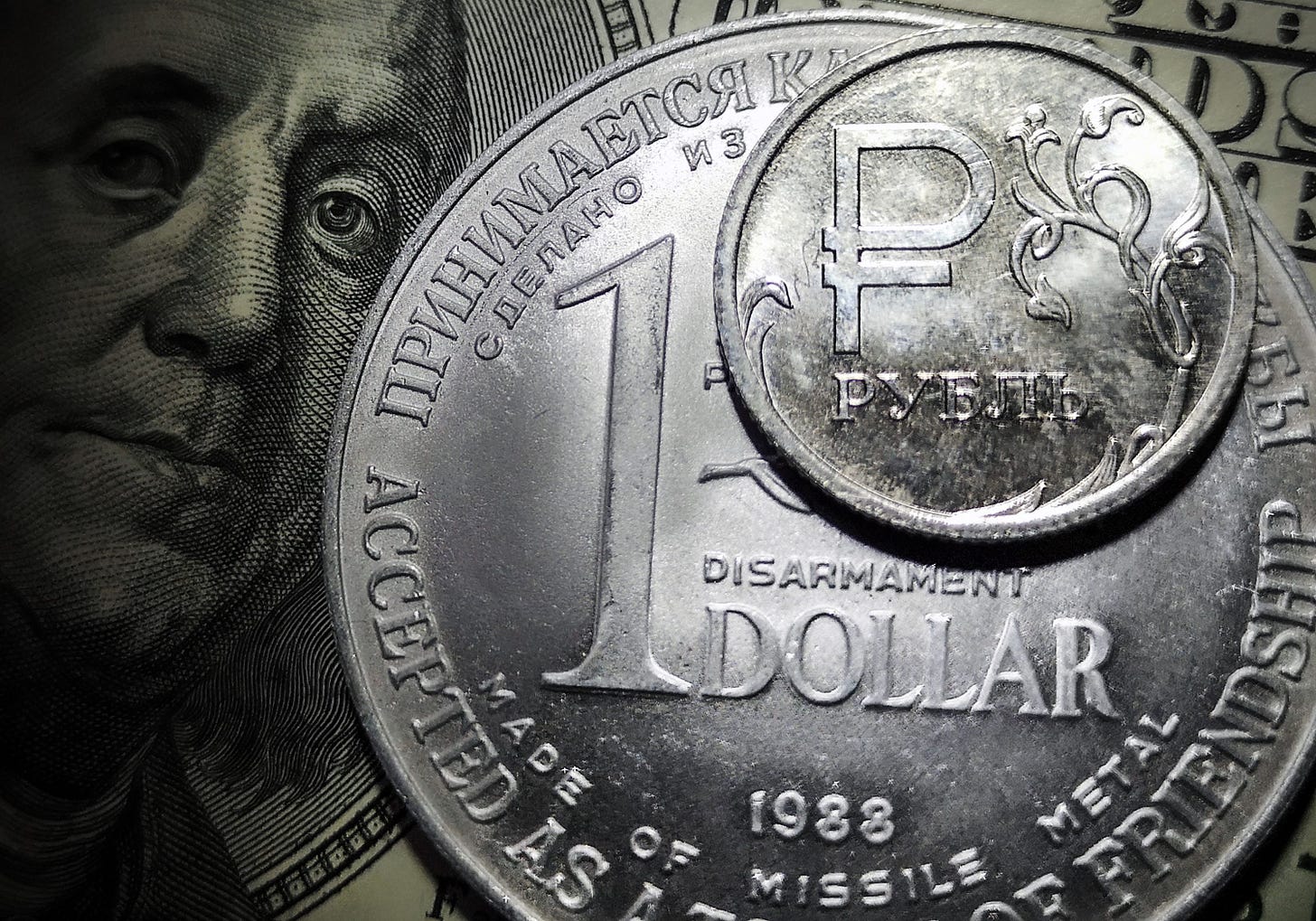Turning Russian Money into Ukrainian Ammunition
There is already a legal mechanism allowing President Biden to take such an action.

RIGHT NOW, ROUGHLY $38 BILLION in frozen Russian assets is sitting in the coffers of American financial institutions. With the stroke of a pen, President Joe Biden can send those funds to Kyiv, and so turn an authoritarian adversary’s wealth into a defensive weapon for besieged Ukrainians—and democracy.
The White House’s power to do this, especially useful now that war in the Middle East guarantees increased competition for foreign aid, comes from the International Emergency Economic Powers Act (IEEPA) of 1977. President George H.W. Bush used this statute in 1992 to transfer frozen Iraqi assets after Saddam Hussein invaded Kuwait; the funds were later transferred to a United Nations commission created to help rebuild Kuwait.
Last month, our organization, the Renew Democracy Initiative, released an analysis examining the president’s powers under IEEPA in the context of the Russian invasion of Ukraine, as well as the moral and practical considerations involved in doing so.
The authors, led by constitutional law scholar Laurence Tribe, determine that IEEPA empowers the president to transfer frozen foreign assets in U.S. financial institutions from one entity to another following the declaration of a national emergency. (The language of IEEPA itself grants the president the power to “direct or compel” the “transfer” of “property,” and Tribe et al.’s analysis confirms that those terms apply in this case.) President Biden is already two-thirds of the way there: Last year, he continued and even expanded the national emergency that was declared under IEEPA after Russia’s 2014 invasion, while the Treasury Department froze Russian assets. All that’s left is to turn them over to Ukraine.
Doing so is legal under American law and entirely consistent with established international law. Tribe and his coauthors conclude that the Constitution “would not prohibit the transfer of Russian assets to Ukraine because Russia, as a foreign sovereign, lacks both due process and takings rights under the Fifth Amendment.” Internationally, the doctrine of countermeasures permits the United States and others to respond as needed—even with an action that would otherwise be impermissible under international law—to get a state that had previously broken international law to return to compliance. In this case, Russia’s illegal invasion of Ukraine clearly permits the United States and its allies to confiscate Russian assets and give them to Ukraine
Tribe and his coauthors argue that Russia’s frozen assets can and should be used to finance Ukraine’s reconstruction—while also imposing no restrictions on how Kyiv spends the money. The bills for Ukraine’s rehabilitation are mounting, and there’s a clear logic to freeing the funds for rebuilding now. With the war still raging, we would go a step further: Kyiv can and should use the funds now to make a dent on the battlefield.
There’s a real opportunity here. In addition to the $38 billion1 in Russian assets frozen in U.S. banks, there are hundreds of billions in banks in the United Kingdom, Canada, European Union members, and Japan. If our democratic allies follow America’s lead, Ukraine could put as much as $300 billion toward bolstering its military. With Washington’s leadership, it’s likely many of our partners would act. Indeed, Estonia has already set up the legal mechanisms to transfer frozen Russian assets to Ukraine, and Canada is moving in this direction as well.
As the second anniversary of Russia’s reinvasion nears, analysts say Ukraine needs a wide array of military hardware to continue its fight. House Republicans have been turning against sending more support to Ukraine, and just installed as speaker of the House a representative who opposes further aid. In the long term, Kyiv needs congressional support, which is why President Biden asked Congress for an additional $60 billion. But while the House remains gridlocked, the president has the authority and responsibility to allocate $38 billion in frozen Russian assets for Ukraine’s defense.
As talk of sending Russian funds to Ukraine gains traction, some commentators have raised the threat of de-dollarization. Their thinking is that other countries, fearing their assets will be seized, will abandon the dollar. As Gillian Tett recently wrote in the Financial Times, delivering Russian funds to Ukraine could “undermine international faith in the safety of dollar assets,” thereby severely weakening the U.S. economy. (It would also limit the effectiveness of American sanctions—after all, transactions that don’t touch the U.S. financial system or use the dollar are generally out of reach for the Treasury.)
But the threat of de-dollarization is minimal. The dollar enjoys significant institutional advantages due to a massive network effect, with eight decades as the undisputed leading global reserve currency. According to the IMF, almost 60 percent of all global reserves are in dollars. This alone doesn’t guarantee the dollar’s future role, but there’s nothing to suggest that transferring Russian assets to Ukraine would unduly damage it. Instead, it would make clear that flagrant aggression has consequences and so, to the extent that it does set a precedent, it would be a positive one: Invade your neighbor, and you might end up bankrolling your own military defeat. This kind of move is consistent with the administration’s recent decision to give Ukraine arms seized from Iran, an active accomplice in Russia’s war. Now the administration needs to go after the primary culprit.
Most countries want peaceful relations with their neighbors and have nothing to fear and everything to gain from a system in which these rules are respected. Even China has little cause for concern, unless it wishes to repeat Russia’s mistakes by forcibly “reintegrating” Taiwan.
In Ukraine’s struggle to repel Putin’s forces, there is no substitute for regular U.S. assistance. But President Biden needs to be realistic: Congressional support for Ukraine—and all else—is in question. But $38 billion in frozen Russian assets is within the president’s reach—and grasping it would very likely encourage the disgorgement of many times that sum from allied countries around the globe. Doing so wouldn’t require congressional approval. It would put Russian money to work in the defense of a beleaguered democracy and would serve as a mechanism for enforcing international norms against aggression.
One interesting wrinkle: In 2015, a U.S. federal court awarded a judgment of $44 million against the Russian government to Chabad Lubavitch, a Hasidic Jewish organization whose library the Red Army stole during World War II and which is still in Russia. If the government decided not merely to freeze Russian assets, as it has done, but to confiscate them, it’s unclear if it would be obligated to pay Chabad their judgment before delivering the rest to Ukraine. The Ukrainians, no doubt, would happily part with the $44 million as the price of receiving the remainder of the $38 billion.







